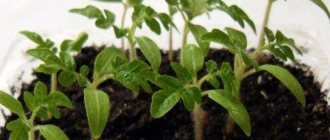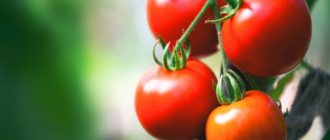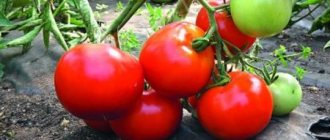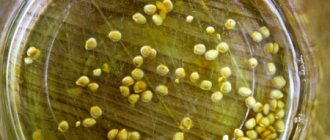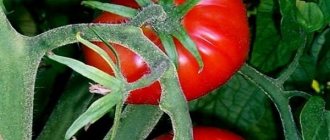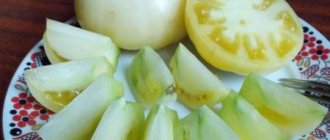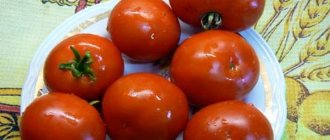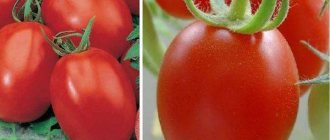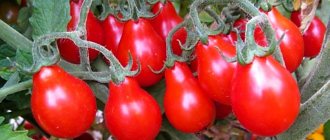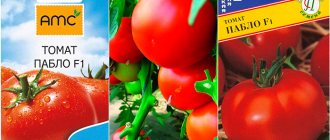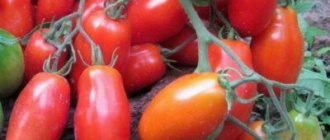Altai breeders have developed a wonderful variety suitable for cultivation both in open ground and in greenhouse conditions. The Altaechka tomato is included in the State Register of the Russian Federation for cultivation on private farms.
| Height | Landing location | Ripening time | Fruit color | Fruit size | Origin | Fruit shape |
| short | Greenhouse, Open ground | Early ripening | Reds | Average | Variety | Plum-shaped or oval |
Features of the variety
A detailed description of the variety will allow a novice summer resident to avoid many problems when growing tomatoes. It is only important to correctly follow the instructions of experienced gardeners and fulfill simple agrotechnical requirements.
Plant:
- Bush: standard, determinate.
- Height: 700–900 cm.
- Inflorescence: simple.
- Number of tomatoes in a brush: 3–6 pcs.
- Ripening time is 95–100 days.
Fruit:
- Shape: oblong or ovoid.
- Color: red with a raspberry tint.
- Weight: 150–300 g.
- Density: high.
- Skin: thin.
- Taste: rich tomato.
- Number of cameras: 4–6 pcs.
- Transportability: high.
- Shelf life: 1–1.5 months.
The best standard varieties of tomatoes for open ground - characteristics and descriptions
Standard tomato varieties bred for open ground are unpretentious, adapt well to the weather, and are easy to cover when it gets cold.
Severin
The dense shell protects the tomatoes during transportation and storage; the plum-shaped fruit weighs 60-80 grams. The bush meets all the characteristics of the standard ones - persistent, dense, height up to 50 centimeters. Tolerates drought and heat well.
Gold
The yellow-orange fruits are pleasing to the eye and contain almost no allergens. The size is impressive - 150-200 grams. The pinching recommended for the plant helps to increase the yield.
Kobzar
The main advantage of the variety is the excellent taste of medium-sized fruits (up to 100 grams). Bright red tomatoes are used for preparations and salads.
Summer resident
Up to 10 ovaries develop on the clusters, the variety is early, fruiting begins 85-90 days after emergence. The shape is flat, the color is bright red. For early varieties it demonstrates a high yield - 3-4 kilograms per bush.
Oak
Grows well in cold regions. Harvest ripening is smooth and early. Tomatoes are sweet in taste, round, juicy. The bush does not grow more than 50 centimeters.
Visibly-invisibly
For lovers of pink tomatoes, breeders created this low-growing variety. The fruits are round and weigh up to 300 grams. From the bush you get up to 5 kilograms of smooth tomatoes, which can be canned and eaten fresh.
Altaechka
This is a popular standard large-fruited tomato that has excellent reviews from summer residents. The bush grows up to 90 centimeters, the weight of tomatoes reaches 200-300 grams. Growers recommend garter because of the heavy tomatoes and abundant fruiting.
Bakhtemir
The bush does not grow higher than 50 centimeters, the tomatoes are red, round in shape. They do not lose their taste for up to 3 weeks and are convenient for long-distance transportation.
Ultra early ripening
A small bush bears fruit within 70 days. The brush contains 8 slightly elongated tomatoes. Despite early ripening, the tomatoes are sweet and the flesh is dense, which makes long-distance transportation possible.
Planting and care
Tomatoes of the “Altaechka” variety are planted in open ground and in greenhouses. Cultivation by seedling method is recommended. Seeds are sown 2 months before planting in a permanent place.
In order for the seeds to germinate faster, the containers with the crops can be tightly closed with glass or ordinary polyethylene.
To strengthen seedlings you need to:
- Dive. Seating in separate containers. Do it when 2 true leaves appear.
- Hardening. 1–2 weeks before transplantation to a permanent place. Starting from 20 minutes and gradually extending the time spent on the street to one day.
No work is required to form the plant. There is no need for a garter to the support. Watering with warm water, preferably in the evening. Weeding and hilling as necessary.
Plant 6 plants per 1 m2, 50 cm between bushes and 40 cm between rows. Compliance with all agrotechnical requirements will help you get an excellent harvest.
Tomato Altaechka
Description and characteristics of the Altaechka tomato variety, reviews, photos
An early-ripening, low-growing, determinate, large-fruited tomato variety from Altai breeders.
The bush is standard, 0.7-0.9 meters high, does not require pinching. A garter to a support is desirable. Medium sized leaf, dark green. The inflorescence is simple.
Basic qualities of fruits
The fruits are ovoid, medium density, red-crimson in color at maturity, weighing 130-300 grams, good taste. Transportable and lightweight. These tomatoes are good for canning, fresh consumption, and processing.
Thanks to its early ripening, this tomato “escapes” late blight, that is, it manages to yield the harvest before its onset.
The Altaechka tomato variety is included in the State Register of the Russian Federation for cultivation in open ground and under film covers on private farms.
Features of cultivation, planting and care
We recommend sowing the seeds of this tomato variety for seedlings 55-60 days before the intended planting in the ground. Seedlings dive at the stage of two true leaves. When planting seedlings in a permanent place per 1 sq. It is recommended to place up to 6 plants per meter of plot. Planting pattern : 50 x 40-30 cm.
Further care for tomatoes consists of timely watering, fertilizing with complex mineral fertilizer, pinching and preventive measures to protect against diseases and pests.
If you grew Altaechka tomatoes, please write whether you liked them or not. What was the yield and taste of the fruits in your climatic conditions? Briefly describe the advantages and disadvantages of this tomato in your opinion. If possible, attach to the comment a photo of the entire bush as a whole or individual fruits that you grew. Thank you!
Your reviews of the Altaechka tomato and additions to the description will help many gardeners evaluate this variety more objectively and decide whether it is worth planting or not.
Disease susceptibility
The main advantage of all tomatoes is immunity to diseases to which the crop is most often susceptible. Late blight is a problem for most gardeners. “Altaechka” tomatoes have time to ripen even before its active spread. Other diseases are not dangerous with timely preventive treatment.
See also
Characteristics and description of the tomato variety Neighbor's envy f1Read
Altaechka – variety of tomato plant
Variety characteristics:
Properties of the Altaechka variety:
Recommended region on the map:
Information on the admission of Tomato Altaechka from the Register of the State Variety Commission of the Russian Federation
Application for admission No. 44048, registered 2005-12-07. The Tomato variety Altaechka was included in the register of those approved in 2007. Approved for use in regions: All regions.
The originator of the Tomato Altaechka variety is:
Other varieties of tomato plant
Search for variety by name
Variety selection
Question to the portal experts
If you haven't found the answer to a question, don't hesitate to ask an expert.
Positive and negative characteristics of the variety
A certain characteristic of a variety, divided into positive and negative, helps a beginning summer resident when rejecting a variety.
Pros:
- Harvest volume.
- The fruits do not crack.
- Tomatoes tolerate transportation well and retain their presentation.
- Forming a bush is not necessary.
- Immunity to late blight.
The variety has no significant disadvantages; they have not been identified or are inconsistent.
Description of the tomato variety Zlatov, its characteristics and cultivation
The Zlatova tomato is a hybrid variety that has an unusual tomato color - orange with a tinge of yellowish color. The culture belongs to a variety of universal species, as it can be grown in outdoor and greenhouse conditions. The highest yields are achieved when grown in closed structures.
The culture belongs to varieties with an average ripening period. The bushes can reach a height of up to 1.5 m. It is recommended to form shoots into 1 or 2 main stems. Due to its high size, the plant needs staking and periodic pinching work.
Features of the fruit
When cut, the fruits have a reddish flesh. The average weight of a tomato is 100 grams. The fruits are round in shape and contain a small amount of seeds.
Description of the advantages of the hybrid variety:
- resistance to most tomato diseases;
- high yields regardless of environmental conditions;
- good ability to withstand mechanical damage, tomatoes tolerate difficult conditions of long-term transportation;
- Can be used fresh and for canning.
Reviews from gardeners confirm the characteristics of the variety in the form of good taste and juicy tomato pulp. Tomatoes are ideal for fresh use in salads, as an ingredient in first and second courses.
Recommendations for planting
The culture involves the use of seedling growing methods. It is recommended to disinfect the seeds before planting. When using used containers, it is recommended to pre-treat them, which will reduce the risk of disease in seedlings.
Sowing of planting material is carried out from the end of March to April. The plant is demanding of sufficient sunlight, the amount of which will determine the height and health of the seedlings. For planting, select soil with a high peat content, the amount of which should be at least 40%. The soil requires the presence of a large amount of mineral components and microelements.
When using soil from a personal plot, preliminary treatment in the form of steaming or calcination is necessary.
It is recommended to place drainage material at the bottom of the planting container, which will remove excess moisture and prevent rotting of the roots. To do this, you can use small charcoal with pieces no larger than 6 cm in size, which is mixed with the ground. Sowing of seeds is carried out at a distance of 3 cm. After planting, the soil is treated with a weak solution of potassium humate using a sprayer.
After planting the seeds, the containers are placed in a dry room and the temperature is maintained within 30 C0. The first shoots appear on the 10th day. The seedlings need to be provided with a sufficient amount of light, otherwise they will stretch and thin. The temperature during the growing period of seedlings is 20 C0.
Recommendations for planting
Before planting in a place of permanent growth, seedlings are hardened off. To do this, a “hard” temperature regime is provided for 2 hours a day, reducing it at night to 15 C0, at night to 8 C0. The seedlings are ready for planting 55 days after emergence.
The soil is pre-prepared before planting. To do this, the following components are added to each meter:
- 55 grams - superphosphate;
- 55 grams - potassium sulfate;
- 50 grams - ammonium sulfate.
Planting is carried out at an air temperature of at least 13 C0. The recommended furrow width is 45 cm, planting is carried out at a depth of 20 cm. Before planting, it is recommended to fertilize the grooves with Fitosporin or Baikal. Before planting, the seedlings are not watered for 2 days, but 30 minutes before transplanting they are moistened abundantly. The first watering is carried out after 10 days. Further care involves standard agricultural cultivation techniques. A couple of weeks before ripening, they stop feeding the bushes with fertilizers.
Tomato Altaechka: characteristics and description of the variety, yield with photos
Summer resident
Registration: 1.8.2004 Messages: 2837 From: Ashkelon
I would change the title of the topic to: “Varieties of tomatoes sold in Siberia by the company “Siberian Garden””
This was indeed true.
Companies that sell seeds, purchasing them in bulk, including from us, and packaging them in their own bags, sometimes receive from the true seed manufacturer the right not to indicate the name of the manufacturer on the packaging. For example, most of the seeds produced in Israel are known in the world under Dutch trademarks. And this does not bother our producers at all!
High-quality seeds can only be produced in conditions suitable for full ripening and large yields. However, the market is the market! Need to sell! If on the packages the seller indicates that the seeds of Moulin Rouge are grown in France, and Koenigsberg in Germany, and for example Fernanda-1652 in Israel, then sales volumes may be reduced
So dear summer residents! Buy seeds, grow them, experiment. There's nothing wrong. Many seeds of varieties grown thousands of kilometers from your city can grow and bear fruit well in Siberian conditions. Real Siberian seeds can be found somewhere in a Siberian village, from a grandmother who has been growing her favorite variety for 50 years.
Summer resident
Registration: 8.4.2005 Messages: 227 From: kuzbass
But about “Pink Honey” it is written that it is of West Siberian selection, “Kenigsberg” is generally a variety of Siberian amateur breeders
Yes, the question arose from the fact that the areas are not rubber, but I want to try something new. So you think - well, not only were these seeds sold to me last year, someone has already tried it and will share their experience
For the answer, uv. FFR, thank you very much!
Summer resident
Registration: 2/26/2004 Messages: 3012 From: Lipetsk
Dacha in SNT “Druzhba”
Of course, this may be true, but no one has canceled the regulated descriptions of varieties in reference books.
In the description on the pack, as always, the yield of 2-3 buckets per plant is touching. Although maybe buckets grow on it?
Originators of Rose Honey
all the same residents of the city of Novosibirsk: DEDERKO VLADIMIR NIKOLAEVICH and POSTNIKOVA OLGA VALENTINOVNA. But what is strange (interesting-suspicious)! An application for a patent and permission for selection achievements to be used was filed on December 7, 2005. But it is already on sale and has already proven itself!
Summer resident
Registration: 1.8.2004 Messages: 2837 From: Ashkelon
I didn't mean all varieties.
However, I know quite well the history of the creation of varieties, for example Titan and Veneta Official, registered everywhere and perfectly described.
For this reason, most of the varieties sold by leading seed companies are not varieties, but F1 hybrids and the fact that these are hybrids, and the parental forms are very well protected, is a guarantee of the variety (F1 hybrid quality). And no one even has the thought of patenting parent forms. They are stored in secure safes.
All over the world, productivity is certainly not measured in buckets. For the same tomatoes, as for a biological species, there are certain biological ceilings of productivity, so to speak. Productivity depends not so much on the variety as on the growing conditions. The shape, size, weight, density, sugar content, fruit color, and keeping quality may depend on the variety. And the overall yield is a matter of growing conditions and care. Here, farmers know what can be obtained from 1 square of protected soil - up to 50 kg. In the field up to 30-35. Productivity may vary slightly depending on the variety in one direction or another. But the main indicator is commercial quality.
Well, about buckets: There are buckets of 7, 10, 12 liters. There are buckets that children use to play in sandboxes. What is meant by the word bucket in the annotation in the seeds? For what conditions? Open ground, film covering, greenhouse, trellis, plant density per square meter? All this will affect the yield.
